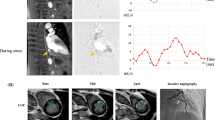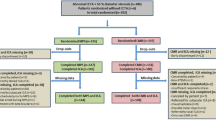Abstract
Objective
To examine the additional prognostic value of coronary CT angiography (CTA) over myocardial perfusion imaging (MPI) in patients with suspected or known coronary artery disease.
Methods
A series of 157 patients (mean age 69 ± 9 years; 76% male; median follow-up 49 months; range 12–82 months) underwent stress MPI with SPECT and coronary CTA within a 6-month interval. Summed stress score (SSS) and summed difference score (SDS) of stress MPI, number of vessels with stenosis, and presence of left main trunk stenosis and high-risk plaques on coronary CTA were examined. Primary endpoints were cardiac death, acute myocardial infarction, or unstable angina requiring revascularization. Secondary endpoints were revascularization > 60 days after the latter imaging test. All patients were followed up for at least 1 year (mean 45 ± 19 months; range 12–82 months).
Results
Nine (6%) patients reached primary endpoints. Cardiac death occurred in 1 (0.6%) patient, myocardial infarction in 5 (3%), and unstable angina requiring hospitalization in 3 (2%). Elective revascularization within 60 days was performed in 31 (20%) patients. Sixteen (10%) patients required revascularization after > 60 days. Primary endpoint event-free survival rates were significantly lower in patients with myocardial ischemia (SDS ≥ 2) and high-risk plaques (HRP), and secondary endpoint event-free survival rates in patients with SSS ≥ 4 and 3VD. In multivariate analysis, Cox proportional hazards regression analysis revealed HRP (HR = 8.02; P = 0.006) and myocardial ischemia (HR = 11.487; P = 0.025) were significant predictors of primary endpoints, and 3VD of secondary endpoints (HR = 4.981; P = 0.008). Combined ischemia and HRP resulted in the significant increase of the model Chi square in prediction of primary end points from ischemia or HRP alone (17.4 vs. 9.41; P = 0.005, 17.4 vs. 9.39; P = 0.005, respectively).
Conclusion
Coronary CT angiography may provide additional prognostic information over MPI.




Similar content being viewed by others
References
Hachamovitch R, Berman DS, Shaw LJ, Kiat H, Cohen I, Cabico JA, et al. Incremental prognostic value of myocardial perfusion single photon emission computed tomography for the prediction of cardiac death: differential stratification for risk of cardiac death and myocardial infarction. Circulation. 1998;97:535–43.
Nishimura T, Nakajima K, Kusuoka H, Yamashina A, Nishimura S. Prognostic study of risk stratification among Japanese patients with ischemic heart disease using gated myocardial perfusion SPECT: J-ACCESS study. Eur J Nucl Med Mol Imaging. 2008;35:319–28.
Virmani R, Burke AP, Farb A, Kolodgie FD. Pathology of the vulnerable plaque. J Am Coll Cardiol. 2006;47(8 Suppl):C13–8.
Falk E, Shah PK, Fuster V. Coronary plaque disruption. Circulation. 1995;92:657–71.
Berman DS, Kang X, Hayes SW, Friedman JD, Cohen I, Abidov A, et al. Adenosine myocardial perfusion single-photon emission computed tomography in women compared with men. Impact of diabetes mellitus on incremental prognostic value and effect on patient management. J Am Coll Cardiol. 2003;41:1125–33.
Min JK, Shaw LJ, Devereux RB, Okin PM, Weinsaft JW, Russo DJ, et al. Prognostic value of multidetector coronary computed tomographic angiography for prediction of all-cause mortality. J Am Coll Cardiol. 2007;50:1161–70.
Pundziute G, Schuijf JD, Jukema JW, Boersma E, de Roos A, van der Wall EE, et al. Prognostic value of multislice computed tomography coronary angiography in patients with known or suspected coronary artery disease. J Am Coll Cardiol. 2007;49:62–70.
Motoyama S, Kondo T, Sarai M, Sugiura A, Harigaya H, Sato T, et al. Multislice computed tomographic characteristics of coronary lesions in acute coronary syndromes. J Am Coll Cardiol. 2007;50:319–26.
Motoyama S, Sarai M, Harigaya H, Anno H, Inoue K, Hara T, et al. Computed tomographic angiography characteristics of atherosclerotic plaques subsequently resulting in acute coronary syndrome. J Am Coll Cardiol. 2009;54:49–57.
Otsuka K, Fukuda S, Tanaka A, Nakanishi K, Taguchi H, Yoshikawa J, et al. Napkin-ring sign on coronary CT angiography for the prediction of acute coronary syndrome. JACC Cardiovasc Imaging. 2013;6:448–57.
Morise AP, Haddad WJ, Beckner D. Development and validation of a clinical score to estimate the probability of coronary artery disease in men and women presenting with suspected coronary disease. Am J Med. 1997;102:350–6.
Austen WG, Edwards JE, Frye RL, Gensini GG, Gott VL, Griffith LS, et al. A reporting system on patients evaluated for coronary artery disease: report of the Ad Hoc Committee for Grading of Coronary Artery Disease, Council on Cardiovascular Surgery, American Heart Association. Circulation. 1975;51:5–40.
Germano G, Kavanagh PB, Waechter P, Areeda J, Van Kriekinge S, Sharir T, et al. A new algorithm for the quantitation of myocardial perfusion SPECT. I: Technical principles and reproducibility. J Nucl Med. 2000;41:712–9.
Cerqueira MD, Weissman NJ, Dilsizian V, Jacobs AK, Kaul S, Laskey WK, et al. Standardized myocardial segmentation and nomenclature for tomographic imaging of the heart—a statement for healthcare professionals from the Cardiac Imaging Committee of the Council on Clinical Cardiology of the American Heart Association. Circulation. 2002;105:539–42.
Berman DS, Kiat H, Friedman JD, Wang FP, van Train K, Matzer L, et al. Separate acquisition rest thallium-201/stress technetium-99m sestamibi dual-isotope myocardial perfusion single photon emission computed tomography: a clinical validation study. J Am Coll Cardiol. 1993;22:1455–64.
Mazzanti M, Germano G, Kiat H, Kiat H, Kavanagh PB, Alexanderson E, et al. Identification of severe and extensive coronary artery disease by automatic measurement of transient ischemic dilation of the left ventricle in dual-isotope myocardial perfusion SPECT. J Am Coll Cardiol. 1996;27:1612–20.
Kakhki VR, Sadeghi R, Zakavi SR. Assessment of transient left ventricular dilation ratio via 2-day dipyridamole Tc-99m sestamibi nongated myocardial perfusion imaging. J Nucl Cardiol. 2007;14:529–36.
Alpert JS, Tygesen K. Myocardial infarction redefined—a consensus document of The Joint European Society of Cardiology/American College of Cardiology Committee for the redefinition of myocardial infarction. Eur Heart J. 2000;21:1502–13.
Bassand JP, Hamm CW, Ardissino D, Boersma E, Budaj A, Fernández-Avilés F, et al. Guidelines for the diagnosis and treatment of non-ST-segment elevation acute coronary syndromes. Eur Heart J. 2007;28:1598–660.
Sharir T, Germano G, Kavanagh PB, Lai S, Cohen I, Lewin HC, et al. Incremental prognostic value of post-stress left ventricular ejection fraction and volume by gated myocardial perfusion single photon emission computed tomography. Circulation. 1999;100:1035–42.
van Werkhoven JM, Schuijf JD, Gaemperli O, Jukema JW, Boersma E, Wijns W, et al. Prognostic value of multislice computed tomography and gated single-photon emission computed tomography in patients with suspected coronary artery disease. J Am Coll Cardiol. 2009;53:623–32.
Motoyama S, Sarai M, Inoue K, Kawai H, Ito H, Harigaya H, et al. Morphologic and functional assessment of coronary artery disease—potential application of computed tomography angiography and myocardial perfusion imaging. Circ J. 2013;77:411–7.
Shaw LJ, Berman DS, Maron DJ, Mancini GB, Hayes SW, Hartigan PM, COURAGE Investigators, et al. Optimal medical therapy with or without percutaneous coronary intervention to reduce ischemic burden: results from the Clinical Outcomes Utilizing Revascularization and Aggressive Drug Evaluation (COURAGE) trial nuclear substudy. Circulation. 2008;117:1283–91.
Acknowledgements
All authors have no relationships relevant to the contents of this paper to disclose.
Author information
Authors and Affiliations
Corresponding author
Ethics declarations
Conflict of interest
There is no conflict of interest among all authors of this study.
Rights and permissions
About this article
Cite this article
Kiriyama, T., Fukushima, Y., Hayashi, H. et al. Feasibility of combined risk stratification with coronary CT angiography and stress myocardial SPECT in patients with chronic coronary artery disease. Ann Nucl Med 32, 22–33 (2018). https://doi.org/10.1007/s12149-017-1214-z
Received:
Accepted:
Published:
Issue Date:
DOI: https://doi.org/10.1007/s12149-017-1214-z




